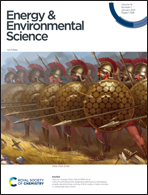Tailoring the linking patterns of polypyrene cathodes for high-performance aqueous Zn dual-ion batteries†
Abstract
Although the utilization of mildly acidic electrolyte can enhance the stability and reversibility of Zn anode, it is still challenging to achieve long cycling life for aqueous Zn batteries at low currents, due to the structural instability of cathode materials during the charge/discharge processes. Herein, we report a series of polypyrenes with different linking patterns and electronic structures as Cl−-hosting organic cathodes for aqueous Zn dual-ion batteries (AZDIBs). The comparative study demonstrates that the electronic structures are pivotal to the redox activity of the polypyrenes, which can be tuned by altering the linking patterns on the pyrene unit. Owing to the high surface area, the highly delocalized HOMO distribution, the high HOMO level and the narrow band gap, the polymer CLPy with 1,3,6,8-linking pattern delivers a much higher capacity of 180 mA h g−1 than the two linear counterparts (24 mA h g−1 for LPy-1 and 44 mA h g−1 for LPy-2). Impressively, CLPy exhibits ultra-stable cyclabilities with the capacity retentions of 97.4% after 800 cycles at 50 mA g−1 and 96.4% after 38 000 cycles at 3 A g−1. CLPy also shows a low self-discharge rate with around 90% capacity retention after resting for 28 days. The excellent electrochemical performance demonstrates that CLPy can be a promising cathode material for high-performance AZDIBs.



 Please wait while we load your content...
Please wait while we load your content...